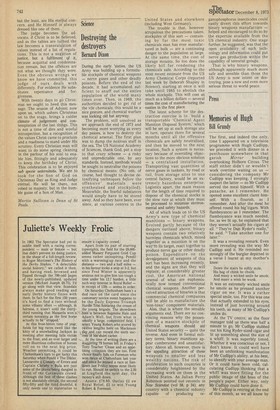Science
Destroying the destroyers
Bernard Dixon
During the early 'sixties, the US Army was building up a formidable stockpile of chemical weapons — nerve gases and other deadly poisons. Before the end of the decade, it had accumulated sufficient to snuff out the entire population of the world many times over. Then, in 1969, the authorities decided to get rid of the vile chemicals; this would be a 'nice gesture, and chemical warfare was looking old hat anyway.
The problem, still unsolved as we approach the end of 1973 and becoming more worrying as every day passes, is how to destroy the chemical arsenal. The first plan was to dump the noxious stuff in the sea. The US National Academy of Sciences, thank God, put a stop to that crazy scheme — a risky and unpredictable one, by any standards. Instead, methods would be sought to neutralise the poisons by chemical means. (No one, of course, had thought to devise detoxifying techniques before the offensive' materials were synthesised and stockpiled). Meanwhile, the fearful substances would simply have to be stored away. And so they have been, ever since, at various centres in the
United States and elsewhere (including West Germany).
The trouble is that, however scrupulous the precautions taken, stockpiles of this sort — containing by far the most toxic chemicals man has ever manufactured in bulk — are a continuing danger to the population at large. At the same time, the cost of storage mounts. So too does the likely bill for rendering the chemicals safe. According to the most recent estimate from the US Army Chemical Corps (reported last week by Deborah Shapley in Science), starting at once it will take until 1985 to abolish the whole stockpile. This will cost as much as a billion dollars — several times the cost of manufacturing the nasties in the first place.
The latest scheme for the destruction exercise is to build a transportable 'Chemical Agent Munition Disposal System,' which will be set up at each storage site in turn, operate there for several months until all the offensive chemicals are safely neutralised, and then be moved to the next location. Such a system is necessary because of overriding objections to the more obvious solution — a centralised installation. Transporting vast quantities of nerve gases in tankers, by road or rail, from storage sites to one central factory, would be an extremely hazardous enterprise. Logistics apart, the main reason for the length of time required to dispose of the chemical stocks is the slow rate at which they must be processed to minimise environmental and safety hazards.
All of which leads on to the US Army's new type of chemical munitions — binary weapons. Evolved partly because of the dangers outlined above, binary weapons contain two relatively harmless chemicals which, mixed together as a munition is on the way-to its target, react together to produce nerve gas or other deadly poison. Expenditure on the deve,lppment of weapons of this sort has been increasing recently, and the signs are that they will replace, at considerably greater' cost, the American national arsenal of what are euphemistically now termed conventional chemical weapons. Another perceived attraction of binaries is that commercial chemical companies will be able to manufacture the 'non-toxic' component materials. Alas, that is where the sensible arguments end. There are no convincing reasons why the possession of a massive stockpile of chemical weapons should aid • United States security — quite the reverse. And even in formal military terms, binary munitions appear cumbersome and unsatisfactory. Above all, however, there is the appalling attraction of these weapons to smaller and less wealthy nations. The risk of proliferation to such countries is considerably heightened by the increasing work on them in the United States. As Julian Perry Robinson pointed out recently in New Scientist (vol 58, p 34), any country with a chemical industry capable of producing or
ganophosphorus insecticides could easily divert this effort towards binary weapons manufacture — , helped and encouraged to do so by the expertise available from the US chemical industry. One stage further, he suggested, was that the open availability of such technology and information could put nerve gas production within the capability of terrorist groups. That is why binary weapons, although apparently much more safe and sensible than those the US Army is now intent on destroying, pose a new and even more serious threat to world peace.










































 Previous page
Previous page